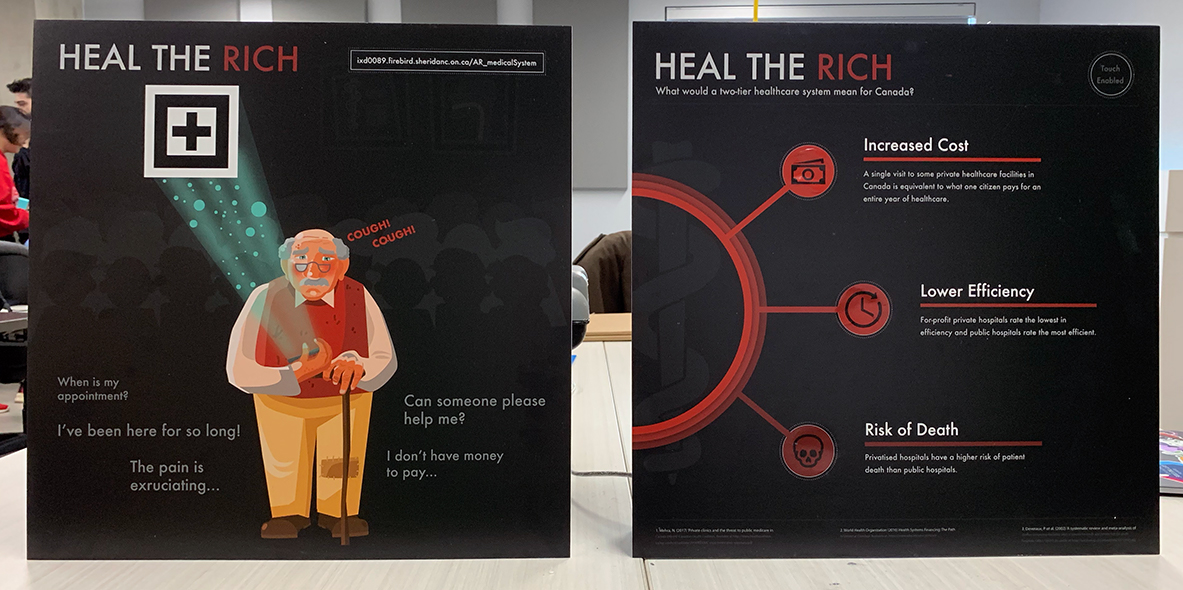Topic: Two-Tier Healthcare
Stance: Ontarians quality of life would fall if we were to adopt two-tier healthcare
The position is given to us despite our personal beliefs. The outcome of the project is to create two interactive posters, one using Arduino’s touch technology, and the other using AR technology. Our stance has to be expressed through signs using Pathos and Logos. Logos for physical computing poster, and Pathos for AR poster.
DESIGN STATEMENT
Our team was challenged to create two posters using both pathos and logos rhetoric. The posters would speak against the implementation of a Two-Tier Healthcare system in Ontario. Through extensive research we learned about the real-life consequences that would negatively affect our society, particularly lower income citizens and families, if Canada were to use this system.
In our logos poster we utilized physical computing to augment the facts we had learned through our research. With this design we aimed for clear, logical statements that proved that a two-tier system would only be an advantage to people who have money in abundance. We used an Arduino microprocessor and touch sensors to provide users with an interactive audio experience. Each of the touch senors is very clearly marked in our design, in order to provide a seamless user journey through the poster’s content.
Our pathos poster focused on influencing the feelings of a viewer, rather than the pure logical facts. In this poster we created an emotional illustration of an elderly sick man. The poster tells the story of a man who has been continuously put at the end of the waiting list to see the doctor despite an aggravating condition. The man’s healthcare is shown being directly impacted by a system that attempts to integrate private and public healthcare, because he cannot afford the priority service given to richer patients. The poster has an augmented reality marker
floating above the man, connected to his phone. When a user follows the URL on the poster, they can scan the AR marker and see a computational UI interface that shows the man’s never ending waiting time.
By making these two posters, we hoped that the viewer would be convinced to vote against the two-tier healthcare system in Ontario.
FINAL DESIGN

PROCESS WORK
RESEARCH
These are copied and pasted, website links to follow below.
Definition of two-tier healthcare:
A healthcare system where everyone can access a basic publicly-funded healthcare program but for those who can afford it, they can access a more robust level of health care with better care or faster access. (https://www.superbrokers.ca/library/glossary/terms/two_tier_healthcare.php)
Cons of two-tier healthcare:
The Council of Canadians – Why we’re fighting against two-tiered health care
- Private clinics increase wait times for the 99%
- While privatisation will remove a small amount of patients from the public health care system, it will remove a larger amount of doctors
- Health care practitioners in the public system see many more patients than those in private systems
- Private clinics provide inferior quality of care
- Studies show that public healthcare does not just cost less – it also provides safer care
- Private hospitals are less efficient
- For-profit private hospitals rate the lowest in efficiency
- Save money by keeping hospitals public, and moving that money back into patient care
- Public-Private-Partnerships cost more, deliver less
- Brampton Hospital in Ontario. It’s known for being built 129 beds short and $300 million over the original estimated cost.
- Patients pay more through taxes and out-of-pocket
- Two-tiered health care allows health care practitioners like Day to exploit the system and make twice the amount of money as they did before.
- When Canada adopted the Canada Health Care Act in 1984, it banned extra billing and user fees
(https://canadians.org/blog/why-were-fighting-against-two-tiered-health-care)
- People perceive private healthcare as the norm and public as the inferior, rather than public as a standard and private as a luxury.
- Private services undermine the public by contracting/taking over profitable services to the public, leaving the public bodies struggling to fund themselves.
- The government relies on private contracting to meet demands rather than investing in public infrastructure or spending decent money on services, thus undermining services in the long run.
- Private hospitals are checked less often for quality!
(https://www.quora.com/What-are-the-pros-and-cons-of-a-two-tier-healthcare-system)
- Canada’s health care system insures that its citizens receive necessary procedures that can only be achieved through the public sector.
- Through the Canada Health Act and provincial legislation, the private sector prevents the sponsorship of medical services such as hip or knee replacements, surgeries, or magnetic resonance imaging.
- Many Canadians support the one-tier system because they believe that every citizen within the country is receiving an equal opportunity of health care.
- Supporters believe that a private sector discriminates against lower-income individuals, offering a lower quality of care.
- Many agree that a centralized public system is more efficient than a system that permits providers and funders.
(http://www.medical-research-papers.com/canadas-health-care-system-one-tier-versus-two-tier.html)
We are reviewing examples of AR designs during class. There’s an app that needs to be downloaded in order to interact with a book.
